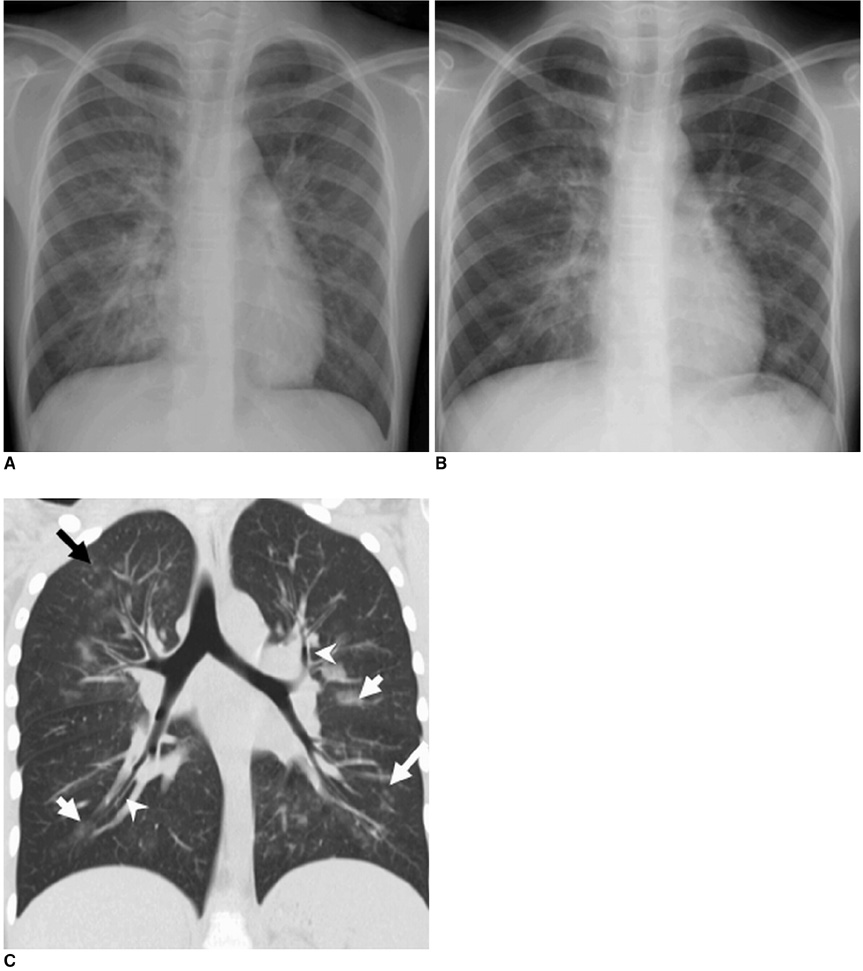Korean J Radiol.
2010 Dec;11(6):656-664. 10.3348/kjr.2010.11.6.656.
Novel Influenza A (H1N1) Virus Infection in Children: Chest Radiographic and CT Evaluation
- Affiliations
-
- 1Department of Diagnostic Radiology, Dankook University College of Medicine, Dankook University Hospital, Chungnam 330-715, Korea. yslee@dkuh.co.kr
- 2Department of Pediatrics, Dankook University College of Medicine, Dankook University Hospital, Chungnam 330-715, Korea.
- KMID: 1119229
- DOI: http://doi.org/10.3348/kjr.2010.11.6.656
Abstract
OBJECTIVE
The purpose of this study was to evaluate the chest radiographic and CT findings of novel influenza A (H1N1) virus infection in children, the population that is more vulnerable to respiratory infection than adults.
MATERIALS AND METHODS
The study population comprised 410 children who were diagnosed with an H1N1 infection from August 24, 2009 to November 11, 2009 and underwent chest radiography at Dankook University Hospital in Korea. Six of these patients also underwent chest CT. The initial chest radiographs were classified as normal or abnormal. The abnormal chest radiographs and high resolution CT scans were assessed for the pattern and distribution of parenchymal lesions, and the presence of complications such as atelectasis, pleural effusion, and pneumomediastinum.
RESULTS
The initial chest radiograph was normal in 384 of 410 (94%) patients and abnormal in 26 of 410 (6%) patients. Parenchymal abnormalities seen on the initial chest radiographs included prominent peribronchial marking (25 of 26, 96%), consolidation (22 of 26, 85%), and ground-glass opacities without consolidation (2 of 26, 8%). The involvement was usually bilateral (19 of 26, 73%) with the lower lung zone predominance (22 of 26, 85%). Atelectasis was observed in 12 (46%) and pleural effusion in 11 (42%) patients. CT (n = 6) scans showed peribronchovascular interstitial thickening (n = 6), ground-glass opacities (n = 5), centrilobular nodules (n = 4), consolidation (n = 3), mediastinal lymph node enlargement (n = 5), pleural effusion (n = 3), and pneumomediastinum (n = 3).
CONCLUSION
Abnormal chest radiographs were uncommon in children with a swine-origin influenza A (H1N1) virus (S-OIV) infection. In children, H1N1 virus infection can be included in the differential diagnosis, when chest radiographs and CT scans show prominent peribronchial markings and ill-defined patchy consolidation with mediastinal lymph node enlargement, pleural effusion and pneumomediastinum.
Keyword
MeSH Terms
Figure
Reference
-
1. Perez-Padilla R, de la Rosa-Zamboni D, Ponce de Leon S, Hernandez M, Quiñones-Falconi F, Bautista E, et al. Pneumonia and respiratory failure from swine-origin influenza A (H1N1) in Mexico. N Engl J Med. 2009. 361:680–689.2. Neumann G, Noda T, Kawaoka Y. Emergence and pandemic potential of swine-origin H1N1 influenza virus. Nature. 2009. 459:931–939.3. Global alert and response: current WHO phase of pandemic alert? update58. World Health Organization Website. Accessed November 12, 2009. www.who.int/csr/disease/avian_influenza/phase/en/index.html.4. Centers for Disease Control and Prevention (CDC) Update: infectious with a swine-origin influenza A (H1N1) virus--United States and other countries, April 28, 2009. MMWR Morb Mortal Wkly Rep. 2009. 58:431–433.5. Update: Swine influenza A(H1N1) infections - California and Texas, April 2009. MMWR Morb Mortal Wkly Rep. 2009. 58:435–437.6. Yun BY, Kim MR, Park JY, Choi EH, Lee HJ, Yun CK. Viral etiology and epidemiology of acute lower respiratory tract infection in Korean children. Pediatr Infect Dis J. 1995. 14:1054–1059.7. Andronikou S. Pathological correlation of CT-detected mediastinal lymphadenopathy in children: the lack of size threshold criteria for abnormality. Pediatr Radiol. 2002. 32:912.8. Song HT, Park CK, Shin HJ, Choi YW, Jeon SC, Hahm CK, et al. Radiologic findings of childhood lower respiratory tract infection by influenza virus. J Korean Radiol Soc. 2002. 47:227–231.9. Kim EA, Lee KS, Primack SL, Yoon HK, Byun HS, Kim TS, et al. Viral pneumonias in adults: radiologic and pathologic findings. Radiographics. 2002. 22:S137–S149.10. Feldman PS, Cohan MA, Hierholzer WJ Jr. Fatal Hong Kong influenza: a clinical, microbiological and pathological analysis of nine cases. Yale J Biol Med. 1972. 45:49–63.11. Agarwal PP, Cinti S, Kazerooni EA. Chest radiographic and CT findings in novel swine-origin influenza A (H1N1) virus (S-OIV) infection. AJR Am J Roentgenol. 2009. 193:1488–1493.12. Lee EY, McAdam AJ, Chaudry G, Fishman MP, Zurakowski D, Boiselle PM. Swine-origin influenza A (H1N1) viral infection in children: initial chest radiographic findings. Radiology. 2010. 254:934–941.13. Oliveira EC, Marik PE, Colice G. Influenza pneumonia: a descriptive study. Chest. 2001. 119:1717–1723.14. Lee CW, Seo JB, Song JW, Lee HJ, Lee JS, Kim MY, et al. Pulmonary complication of novel influenza A (H1N1) infection: imaging features in two patients. Korean J Radiol. 2009. 10:531–534.15. Khater F, Moorman JP. Complications of influenza. South Med J. 2003. 96:740–743.16. Tanaka N, Matsumoto T, Kuramitsu T, Nakaki H, Ito K, Uchisako H, et al. High resolution CT findings in community-acquired pneumonia. J Comput Assist Tomogr. 1996. 20:600–608.17. Mollura DJ, Asnis DS, Crupi RS, Conetta R, Feigin DS, Bray M, et al. Imaging findings in a fatal case of pandemic swine-origin influenza A (H1N1). AJR Am J Roentgenol. 2009. 193:1500–1503.18. Ajlan AM, Quiney B, Nicolaou S, Müller NL. Swine-origin influenza A (H1N1) viral infection: radiographic and CT findings. AJR Am J Roentgenol. 2009. 193:1494–1499.19. Yun TJ, Kwon GJ, Oh MK, Woo SK, Park SH, Choi SH, et al. Radiological and clinical characteristics of a miliary outbreak of pandemic H1N1 2009 influenza virus infection. Korean J Radiol. 2010. 11:417–424.20. Zylak CM, Standen JR, Barnes GR, Zylak CJ. Pneumomediastinum revisited. Radiographics. 2000. 20:1043–1057.21. Damore DT, Dayan PS. Medical causes of pneumomediastinum in children. Clin Pediatr (Phila). 2001. 40:87–91.22. Abolnik I, Lossos IS, Breuer R. Spontaneous pneumomediastinum. A report of 25 cases. Chest. 1991. 100:93–95.
- Full Text Links
- Actions
-
Cited
- CITED
-
- Close
- Share
- Similar articles
-
- Influenza Associated Pneumonia
- Chest Radiographic Findings of Novel Swine-Origin Influenza A (H1N1) Virus Infection in Children
- A Case of Novel Influenza A (H1N1) Virus Pneumonia Complicated Pnemomediastinum and Subcutenous Emphysema
- Radiologic Findings of Influenza A (H1N1) Pneumonia: Report of Two Cases
- RE: Pediatric Novel Influenza A (H1N1) Virus Infection: the Imaging Findings





